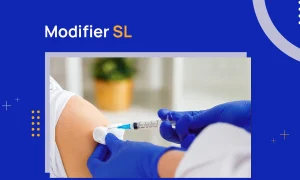Imagine a patient rushes into the ER with chest pain. The doctor immediately orders a troponin test to check for a heart attack. The first result is borderline, so they repeat the test two hours later to see if levels have risen. This can be a critical clue in saving a life. But when the bill is sent to the insurance company, it’s denied. Why? Modifier 91 is missing.
In 2022, the American Medical Association (AMA) estimated that coding oversights like this cost practices over $36 billion annually in lost revenue. That’s why every medical biller and coder needs to learn the proper use of modifiers in their claim. Modifier 91 is one of the most frequently used, so in this blog, we will discuss everything about it.
We will try to understand its purpose, proper application, and how to sidestep common mistakes. So, let’s start.
Modifier 91 Description
The modifier 91 is a type of billing code that is added to the medical claims with the CPT or HCPCS codes to show that a diagnostic laboratory test was performed more than once for the same patient, and on the same date. This is done to gather multiple results when doctors can’t decide the treatment based on a single data point, like the example we gave in the intro.
Please note that you can’t just use modifier 91 every time you repeat a laboratory test. Rather, it is used only when another test is necessary. It’s your way of telling the insurance payers, “This isn’t a mistake; it’s medically necessary.”
Appropriate Use Cases for Modifier 91
To further clarify the concepts, let’s look at a couple of examples where modifier 91 is applicable:
Watching an Allergic Reaction
Consider a scenario where a person gets a severe allergic reaction. The everyday practice for its treatment includes checking the patient’s histamine levels every few hours to see if antihistamines are working.
So, in this case, the medical biller will file the insurance claim as follows:
- First Test: 83088
- Second Test: 83088-91
Here, “83088” is the code for the specific test that was performed, and “91” is used as a modifier to indicate the test replication. It proves these repeats are part of active treatment.
Tracking a Fading Anesthetic
Suppose a patient undergoing surgery gets a blood test to measure lidocaine levels mid-procedure. One hour later, the test is conducted again to ensure it’s clearing safely. Billing:
- First Test: 80197
- Second Test: 80197-91
Blood Glucose Monitoring
Another scenario can be a patient with uncontrolled diabetes being admitted to the hospital. The doctor orders blood glucose tests every two hours to see how the patient responds to insulin therapy. Doing this is essential as the results will determine the type of treatment that will be provided.
The first test establishes a baseline, but each test after that tracks progress. Here’s how you’d bill it:
- First Test: 82947
- Second Test: 82947-91
- Third Test: 82947-91
- And so on.
Modifier 91 flags these as intentional repeats, not mistakes.
Accurate Usage Guidelines for Modifier 91
Using Modifier 91 correctly is essential to avoid claim denials and audits. But this doesn’t mean you put it in every time you repeat a test. Doing this will not only get your claims denied, but the frequent practice might get you penalized. So, let’s understand where you can and can’t use the modifier 91.
When to Use Modifier 91?
Here are some conditions that must be met before using the 91 modifier:
- Same Test, Same Day: The same lab test is repeated for the same patient within a calendar day.
- Medically Necessary Repeats: Additional tests are required to get subsequent results, like tracking a patient’s response to treatment or monitoring a condition’s progression.
- Different Times: The tests happen at separate intervals to provide new data points, not just to verify earlier results.
Plus, an important thing that many healthcare providers take for granted is not focusing on the documentation. So, jot down when each test happened and why.
A 2021 analysis by the Healthcare Financial Management Association (HFMA) found that claims with incomplete documentation were 42% more likely to be denied.
When NOT to Use Modifier 91?
While there can be a lot of scenarios where the use of modifier 91 is not suitable, the following are the main reasons why the insurance companies will deny the claim:
Confirmation Testing: Don’t use it if the test is repeated just to double-check the first result. Insurance companies don’t see this as a medical necessity. But rather as a separate procedure.
Errors or Mishaps: If a test is repeated because of a broken machine, a lost sample, or human error, please don’t use modifier 91. This is a mistake from your end, and the insurance payer is not responsible for reimbursing your loss. Look for other ways to handle those situations, like writing off the cost or using a different code if applicable.
Bundled Test Codes: This can be a little tricky to bill. Some tests, like a glucose tolerance test (CPT 82951), are designed to include multiple samples in one code. Using modifier 91 here would be incorrect. So, stick to the code that fits the procedure.
Modifier 91 vs 59 – Understanding the Difference
If you are a biller or coder, you might already know how confusing it can be to choose between modifier 91 and modifier 59. Even experienced billers sometimes get confused between the two, which means a lot of denials. So, let’s structurally break down the two modifiers to understand them better:
Modifier 91
- Purpose: It signals the repetition of laboratory tests for subsequent results.
- Scope: It is only limited to clinical lab tests. For example, blood work or urinalysis.
- When to Use: The same test is run multiple times on the same day to track a patient’s condition.
- Example: 84132 (first potassium test), 84132-91 (second test).
Modifier 59
- Purpose: The modifier 59 is used when a doctor performs multiple procedures in one session. However, the procedures are different from each other and have no connection.
- Scope: The main difference between the two modifiers is that the scope of modifier 59 is broader. It is not limited to just lab tests like the 91. Rather, it applies to a wide range of procedures, such as surgeries, imaging, or therapy.
- When to Use: Two unrelated services happen on the same day, like a biopsy and a separate wound repair.
- Example: Take the example in the point above. For the biopsy, the biller will enter code 11102. For the wound treatment, the biller will put a separate code with modifier 59, i.e., 12001-59.
Final Thoughts
The modifier 91 might seem like a small addition, but in reality, it has a huge impact on your claims. It ensures you get paid fairly for the repeated lab tests and saves you from claim denials and reduced cash flow.
We believe that with this guide, you are ready to use modifier 91 correctly without any errors. Just back up every test repetition with timestamps and clear medical reasons, and you are good to go.
If you are still feeling overwhelmed by the complexity of medical coding, then the best solution is to outsource medical billing and coding services. Our professional medical coders can help you reduce your denials and increase reimbursement.



